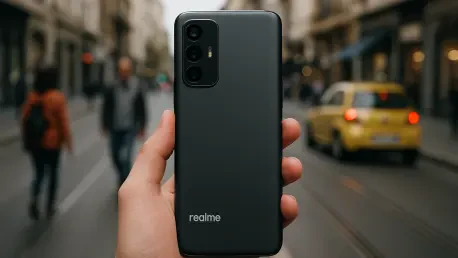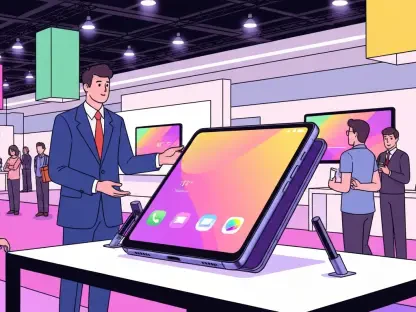What if a smartphone could capture the raw, unfiltered pulse of the streets with the same finesse as a legendary camera used by photography icons? Enter the Realme GT 8 Pro, a device born from an unprecedented collaboration with Ricoh, a name synonymous with street photography excellence. This isn’t just another phone with a decent camera; it’s a bold attempt to redefine how candid, urban moments are immortalized in the digital age. The partnership promises to blend cutting-edge technology with timeless photographic artistry, sparking curiosity about whether a smartphone can truly rival dedicated cameras.
The significance of this story lies in the evolving role of smartphones as serious creative tools. With billions of photos snapped daily on mobile devices, street photography—a genre that thrives on spontaneity and authenticity—has often been limited by the capabilities of typical phone cameras. The Realme GT 8 Pro, as the first fruit of a multi-year alliance with Ricoh, aims to bridge this gap, targeting not just casual users but passionate photographers who crave control and quality. This collaboration signals a broader industry shift toward integrating professional-grade features into everyday devices, making it a pivotal moment for mobile photography.
Capturing the Streets Like Never Before
The essence of street photography is capturing fleeting moments—those unguarded expressions and chaotic urban scenes that tell a story. The Realme GT 8 Pro steps into this arena with a deliberate focus on emulating the iconic Ricoh GR series, a camera line revered by masters of the craft. Designed to fit in a pocket, this smartphone challenges the notion that powerful street photography requires bulky gear, offering a tool that’s as portable as it is potent.
Unlike many smartphones that prioritize flashy filters over substance, this device hones in on the gritty aesthetic that defines the genre. Its camera system, inspired by Ricoh’s legacy, promises to deliver images with depth and character, even in the most challenging environments. Early adopters have already shared glimpses of its potential, with sample shots revealing a striking balance of sharpness and mood that’s rare in mobile photography.
Why Street Photography Matters in the Smartphone Era
Street photography holds a unique place in the visual arts, immortalizing the raw beauty of everyday life in bustling cities and quiet corners alike. In an era where over 1.8 trillion photos are taken annually on smartphones, according to recent industry estimates, this art form struggles to maintain its depth amid automated camera apps that prioritize convenience over creativity. The Realme GT 8 Pro addresses this by offering a platform where artistic intent can shine through, even for those without formal training.
This focus comes at a time when demand for authentic, high-quality mobile photography is surging. Social media platforms are flooded with images, yet only a fraction stand out as truly evocative. By embedding Ricoh’s expertise into a smartphone, the device caters to a growing community of users who want to elevate their snapshots into something more meaningful, reflecting a trend of merging traditional camera strengths with modern accessibility.
The implications extend beyond individual users to the broader cultural landscape. As smartphones become primary tools for documenting life, equipping them with specialized features ensures that the spirit of street photography—its spontaneity and honesty—remains alive, accessible to anyone with a passion for storytelling through a lens.
Unpacking the Photography Powerhouse of Realme GT 8 Pro
Diving into the specs, the Realme GT 8 Pro boasts a 50MP main camera with a 1/1.56” sensor and an f/1.8 lens, enhanced by anti-reflective coatings for unparalleled clarity. It replicates the classic Ricoh GR focal lengths of 28mm and 40mm, paired with a dedicated Ricoh GR Mode featuring five film-inspired profiles like High-Contrast B&W and Negative Film. These modes, complete with customizable GR-style watermarks, allow photographers to craft images with a distinctive, nostalgic edge.
Versatility is another hallmark of this device, extending its appeal beyond urban scenes. A 200MP telephoto camera with a 65mm lens offers 3x optical zoom, ideal for capturing distant subjects or intimate portraits, while a 50MP ultra-wide camera with a 116° field of view excels in expansive landscapes—a significant leap from previous models. For video creators, pro-grade options like 4K 120fps with Dolby Vision and 8K 30fps recording open up cinematic possibilities rarely seen in smartphones.
Initial hands-on impressions suggest that these features translate into real-world performance, with sample images showcasing vivid detail and dynamic range. While comprehensive reviews are still forthcoming, the hardware, combined with Ricoh’s optical influence, positions the device as a serious contender for creators across multiple genres, promising a tool that adapts to diverse artistic needs.
Insights from the Realme-Ricoh Collaboration
Behind the scenes, the partnership between Realme and Ricoh is described as a “full-chain customized system,” encompassing everything from lens design to color rendering and user interface. Powered by the Snapdragon 8 Elite Gen 5 chipset, features like multi-frame fusion enhance performance in low-light conditions and night photography, tackling common pain points for street shooters. This deep integration ensures that the device isn’t just borrowing a name but embodying a legacy.
A Realme spokesperson emphasized the intent behind this alliance, stating, “The mission was to infuse the soul of street photography into a device that fits into daily life seamlessly.” Industry observers echo this sentiment, noting that such collaborations are becoming a strategic move for smartphone brands to differentiate themselves in a saturated market. By aligning with a revered camera manufacturer, Realme taps into a niche audience hungry for authenticity and precision.
This partnership, set to span multiple years starting from 2025, also hints at future innovations. Analysts predict that subsequent products could push boundaries further, potentially integrating even more advanced imaging technologies. For now, the focus remains on delivering a user experience that feels both intuitive and professional, setting a benchmark for what smartphone-camera collaborations can achieve.
Mastering Street Photography with Realme GT 8 Pro
For those eager to explore the streets through this device, leveraging its specialized features is key. Start by experimenting with the Ricoh GR Mode, which offers profiles like Positive Film for vibrant shots or Negative Film for dramatic tones, allowing customization to suit any scene. Adding GR-style watermarks can also give a personal signature to each image, enhancing its artistic value.
Switching between the 28mm focal length for wide, immersive perspectives and the 40mm for tighter, more focused frames mirrors the workflow of classic GR cameras, offering flexibility in composition. In challenging conditions like dusk or shadowy alleys, the multi-frame fusion technology ensures sharp, noise-free results, preserving the integrity of fleeting moments. Expanding beyond street scenes, the ultra-wide and telephoto lenses provide options for cityscapes or candid portraits from afar, broadening creative horizons.
With the device already launched in China and a global rollout imminent, photographers worldwide have an opportunity to redefine their craft. Whether a novice or a seasoned shooter, the tools embedded in this smartphone encourage exploration and mastery of urban storytelling, making every walk through the city a chance to capture something extraordinary.
Reflecting on a Game-Changing Collaboration
Looking back, the collaboration between Realme and Ricoh marked a significant moment in the evolution of mobile photography. The Realme GT 8 Pro stood as a testament to what was possible when smartphone innovation met traditional camera expertise, delivering a device that empowered users to capture the world with newfound depth. Its targeted features for street photography, alongside versatile capabilities for other genres, set a high bar for competitors.
Moving forward, the challenge remains to sustain this momentum through rigorous real-world testing and user feedback. Photographers are encouraged to push the device’s limits, experimenting across diverse environments to uncover its full potential. As the global rollout progresses, the industry watches closely, anticipating how this partnership will continue to shape the intersection of technology and art in the years ahead.









